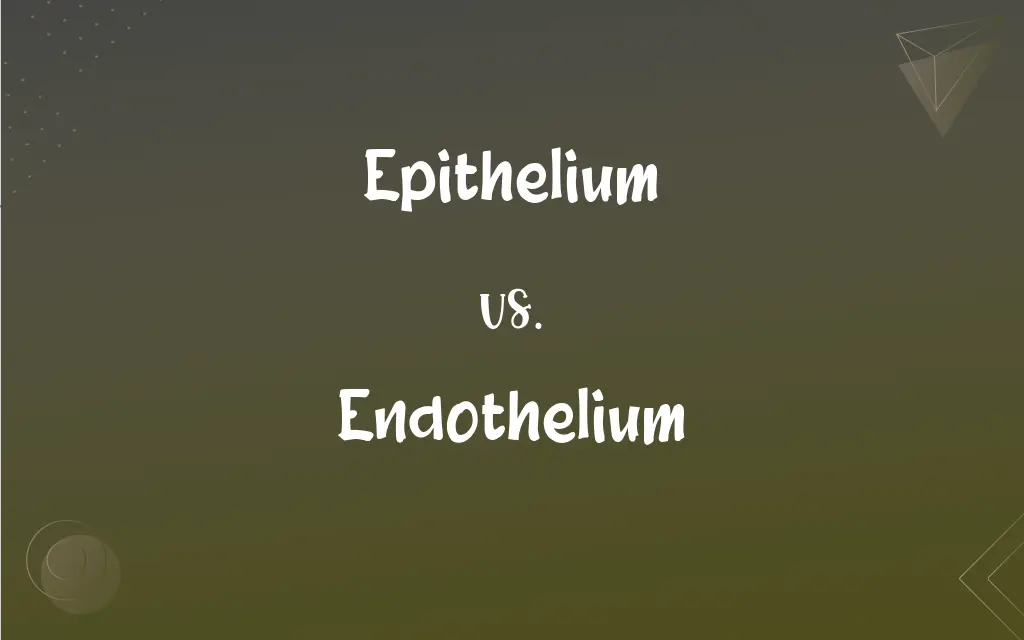Epithelium vs. Endothelium: What's the Difference?
Edited by Aimie Carlson || By Janet White || Published on January 15, 2024
Epithelium is a layer of cells covering external surfaces or lining internal cavities, while endothelium specifically lines the interior of blood vessels and the heart.

Key Differences
Epithelium is a type of tissue that forms a protective layer over the body's external surface and internal cavities. Endothelium, a specific type of epithelium, lines the interior surface of blood vessels and lymphatic vessels.
The epithelium serves various functions such as protection, absorption, and secretion. The endothelium, while also protective, plays a crucial role in vascular biology, including blood clotting, inflammation, and forming new blood vessels.
Epithelial cells can be found in skin, glands, and organs like the intestines and respiratory tract. Endothelial cells, in contrast, are uniquely located in the cardiovascular system.
Epithelium comes in various forms, including squamous, cuboidal, and columnar cells, adapting to different functions and locations. Endothelium is typically a single layer of squamous cells, optimized for smooth blood flow and vascular function.
Both epithelium and endothelium are essential for bodily functions, but they differ significantly in structure and specific roles within the body.
ADVERTISEMENT
Comparison Chart
Location
External surfaces and internal cavities.
Inside blood and lymphatic vessels.
Function
Protection, absorption, secretion.
Blood clotting, inflammation control, vascular function.
Cell Types
Squamous, cuboidal, columnar.
Primarily squamous cells.
Presence in Body
Skin, glands, organs.
Cardiovascular system.
Role
Diverse, based on location.
Specialized in vascular biology.
ADVERTISEMENT
Epithelium and Endothelium Definitions
Epithelium
Lines internal cavities and organs.
The epithelium in the gut aids in nutrient absorption.
Endothelium
Involved in the formation of new blood vessels.
Endothelium aids in the process of angiogenesis.
Epithelium
Tissue forming the outer layer of the body's surface.
The skin's epithelium protects against pathogens.
Endothelium
Acts as a selectively permeable barrier.
The endothelium controls the passage of materials into and out of the bloodstream.
Epithelium
Involved in functions like secretion and sensation.
Glandular epithelium secretes various substances.
Endothelium
Lines the interior of heart and blood vessels.
The endothelium plays a role in regulating blood pressure.
Epithelium
Can regenerate and repair itself.
Damaged skin epithelium can heal over time.
Endothelium
Participates in blood clotting and inflammation.
Endothelial dysfunction can lead to cardiovascular diseases.
Epithelium
Acts as a barrier against the external environment.
The epithelium of the respiratory tract filters air.
Endothelium
Comprises a single layer of squamous cells.
The endothelium's structure ensures smooth blood flow.
Epithelium
Membranous tissue composed of one or more layers of cells separated by very little intercellular substance and forming the covering of most internal and external surfaces of the body and its organs.
Endothelium
A thin layer of flat epithelial cells that lines serous cavities, lymph vessels, and blood vessels.
Epithelium
(anatomy) A membranous tissue composed of one or more layers of cells which forms the covering of most internal and external surfaces of the body and its organs: internally including the lining of vessels and other small cavities, and externally being the skin.
Endothelium
(anatomy) A thin layer of flat epithelial cells that lines the heart, serous cavities, lymph vessels, and blood vessels.
Epithelium
The superficial layer of cells lining the alimentary canal and all its appendages, all glands and their ducts, blood vessels and lymphatics, serous cavities, etc. It often includes the epidermis (i. e., keratin-producing epithelial cells), and it is sometimes restricted to the alimentary canal, the glands and their appendages, - the term endothelium being applied to the lining membrane of the blood vessels, lymphatics, and serous cavities.
Endothelium
The thin epithelium lining the blood vessels, lymphatics, and serous cavities. See Epithelium.
Epithelium
Membranous tissue covering internal organs and other internal surfaces of the body
Endothelium
An epithelium of mesoblastic origin; a thin layer of flattened cells that lines the inside of some body cavities
FAQs
Where is epithelium found?
On skin, in organs, and lining cavities.
What functions does epithelium perform?
Protection, absorption, secretion.
What is epithelium?
A tissue covering body surfaces and lining cavities.
Are there different types of epithelium?
Yes, including squamous, cuboidal, and columnar.
Can epithelium regenerate?
Yes, particularly skin epithelium.
How is endothelium structured?
As a single layer of squamous cells.
What role does endothelium play in the body?
Regulates vascular functions like blood flow and clotting.
Is endothelium involved in angiogenesis?
Yes, it plays a key role.
Does endothelium affect blood pressure?
Yes, through vasodilation and vasoconstriction.
What is endothelium?
A tissue lining the interior of blood vessels and the heart.
Can endothelium repair itself?
Yes, but its repair is critical for cardiovascular health.
Does endothelium have a role in inflammation?
Yes, it's involved in inflammatory responses.
Is endothelium a type of epithelium?
Yes, it's a specialized form.
Does epithelium interact with the immune system?
Yes, particularly in barrier functions.
How does epithelium protect the body?
By forming a physical barrier.
Can epithelium be damaged?
Yes, and it can lead to various disorders.
Is endothelium affected in cardiovascular diseases?
Yes, endothelial dysfunction is a key factor.
Do epithelial cells secrete substances?
Yes, especially in glands.
Are epithelial cells tightly packed?
Yes, to form an effective barrier.
Does endothelium filter blood?
Indirectly, by controlling permeability.
About Author
Written by
Janet WhiteJanet White has been an esteemed writer and blogger for Difference Wiki. Holding a Master's degree in Science and Medical Journalism from the prestigious Boston University, she has consistently demonstrated her expertise and passion for her field. When she's not immersed in her work, Janet relishes her time exercising, delving into a good book, and cherishing moments with friends and family.
Edited by
Aimie CarlsonAimie Carlson, holding a master's degree in English literature, is a fervent English language enthusiast. She lends her writing talents to Difference Wiki, a prominent website that specializes in comparisons, offering readers insightful analyses that both captivate and inform.































































